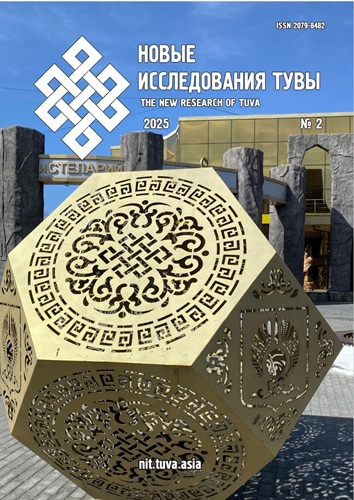The retrospective analysis of the network of specially protected natural territories in the Republic of Tuva
DOI:
https://doi.org/10.25178/nit.2025.2.3Keywords:
Republic of Tuva; specially protected natural area; ecological framework; state nature reserve; natural park; state nature sanctuary; natural monumentAbstract
The article examines the history of the development of the network of specially protected natural areas (SPNAs) located within the territory of the Republic of Tuva. The sources for the study included documents from the National Archives of the Republic of Tuva, materials from state institutions managing SPNAs of the Republic of Tuva, documents published on the Internet, as well as the personal experience of the authors, who were directly involved in the establishment, management, and operation of these areas.
Since 1958, the genesis of 53 SPNAs has been considered, among which 2 (3.8%) are state nature reserves, 5 (9.4%) are natural parks, 30 (56.6%) are state nature sanctuaries of regional significance, 15 (28.3%) are natural monuments of regional significance, and 1 (1.9%) is a natural monument of municipal significance.
The analysis of the network's development by decade revealed that the highest number of SPNAs was established during the periods 1971–1980 — 19 sites (36.5% of the total created in the region), and 1981–1990 — 20 sites (38.4%). In subsequent decades up to 2024, no more than 4 SPNAs were established per decade.
As of August 1, 2024, 35 specially protected natural areas are operating under the management of the SPNAs Directorate of the Republic of Tuva, with a total area of 2,931.1 thousand hectares, representing 17.3% of the region's territory. The network includes the following categories: state nature reserves, a natural park, state nature sanctuaries of regional significance, natural monuments of regional significance, and a natural monument of municipal significance. The process of expanding the SPNAs network continues.
References
Biche-ool, T. N. (2021) Specially protected natural areas of the Republic of Tuva, Vestnik Moskovskogo Universiteta, Issue 5 Geografiya, no. 5, pp. 24–35. (In Russ.)
Dagylga: Tuvan rites of consecration in the 21st century (2021). Ed. by Ch. K. Lamazhaa and N. D. Suvandii. Kyzyl, s. n. 188 p. (In Russ.)
Kanzai, V. I. and Ankhbayar, M. (2013) 20 years to the transboundary Russian Mongolian reserves of Ubsunur hollow. In: Biodiversity of the Altai-Sayan ecoregion: study and conservation in the system of protected areas: Proceedings of the interregional scientific and practical conference (27.06-01.07 2013, Kyzyl). Ed. by A. N. Kuksin et al. Kyzyl, Tyvapoligraf. 176 p. Pp. 10–14. (In Russ.)
Kurbatskaya, S. S. and Arakchaa, L. K. (2013) Ubsu-Nur experiment and Ubsunur Hollow Reserve. In: Biodiversity of the Altai-Sayan ecoregion: study and conservation in the system of protected areas: Proceedings of the interregional scientific and practical conference (27.06-01.07 2013, Kyzyl). Ed. by A. N. Kuksin et al. Kyzyl, Tyvapoligraf. 176 p. Pp. 4–10. (In Russ.)
Sambuu, A. D. and Biche-ool, S.-E. A. (2019) Establishment and expansion of regional protected areas in the Republic of Tuva and biodiversity conservation, Voprosy stepevedeniya, no. XV, pp. 286–290. (In Russ.)
The system of specially protected natural territories of the Altai-Sayan Ecoregion (2001). Ed. by A. N. Kupriyanov. Kemerovo, Aziya. 176 p. (In Russ.)
Skobeev, M. I. (1925) Commercial hunting in the Uryankhai region and its features. Severnaya Aziya, no. 5, pp. 115–122. (In Russ.)
Chistik, Zh. K. (2010) Ecological culture of the Tuvan ethnic group. Kyzyl, Tuvan Book Publishing House. 125 p. (In Russ.)
Published
How to Cite
For citation:
Kuksin A. N., Putintsev N. I., Kuksina D. K. and Archimaeva T. P. The retrospective analysis of the network of specially protected natural territories in the Republic of Tuva. New Research of Tuva, 2025, no. 2, pp. 51-69. (In Russ.). DOI: https://doi.org/10.25178/nit.2025.2.3
Issue
Section

This work is licensed under a Creative Commons Attribution-NonCommercial 4.0 International License.

Author(s) license holder(s) grant rights for their work to the journal (grantee of a license) under the simple non-exclusive open license in accordance with Art. 1286.1 «Open license for a research work, work of literature or fine arts», Civil Code of the Russian Federation.
New Research of Tuva publishes articles under the Creative Commons Attribution-NonCommercial license (CC BY-NC).
Since it is an open license, author(s) reserve the right to upload the article to their institutional repository, submit it to another journal (if it allows republications), or republish it on their own website (in full, or in part).
However, several conditions apply here:
a) The republished version must always contain the name(s) and affiliation(s) of the author(s), the original title and the hyperlink to the original version on the New Research of Tuva website;
b) It must be in open access, free of charge, and no category of readers must be in any way whatsoever advantaged over general readership.
c) should the contribution be submitted elsewhere by its author(s) without substantial modification (30% or more of original text unchanged), the body of the article should contain a disclaimer that the original version was published in New Research of Tuva (with a link to the respective page)
The CC-BY-NC is a non-revocable license which applies worldwide and lasts for the duration of the work’s copyright.












